The best wireless TV headphones
Try Sennheiser or Power Acoustik.

By Daniel Varghese and Lauren Dragan
This post was done in partnership with Wirecutter. When readers choose to buy Wirecutter's independently chosen editorial picks, Wirecutter and Engadget may earn affiliate commission. Read the full wireless tv headphones guide here.
Wireless TV headphones allow you to enjoy TV shows, movies, and video games without disturbing people around you. After spending dozens of hours researching the available options and testing 20 systems, we're confident that the Sennheiser RS 165 is the best one available today. It's easy to set up, sounds much better than the competition, and produces almost no latency between the audio and video (a major problem with many systems).
The Sennheiser RS 165 is the best-sounding wireless TV headphone system we tested, and unlike with most of the competition, we didn't detect any noticeable delay between audio and the video we watched, making for the best experience. The lightweight headphones are comfortable to wear, easy to charge, and easy to add to most existing TVs or home theater setups. The rechargeable batteries last long enough to make it through several movies. This system's price has come down a fair amount since we first tested it, which makes it easier to recommend as our top pick.
If you plan to use your wireless TV headphones only occasionally and/or you want to be able to use multiple pairs at once, consider the Power Acoustik HP-902RFT. Once you've set up this headphone system, it's as easy to use as the Sennheiser RS 165. However, you have to purchase a separate AC power adapter and at least four AAA batteries first because the system doesn't include those. And the plastic headphones feel cheaply made and aren't as comfortable as the Sennheisers. They also sound a little compressed—you'll still be able to understand all of the dialogue in a movie but the score might sound muffled.
Why you should trust us
Lauren Dragan is a senior staff writer for Wirecutter and our resident headphone expert. She has reviewed hundreds of headphones for Wirecutter since 2013. Lauren holds a bachelor's degree in both music performance and audio production from Ithaca College.
Daniel Varghese, who tested the headphones for this update, is a Wirecutter associate staff writer who covers the AV and smart-home categories. He has used many microphones and headphones as a musician, podcast producer, and college radio DJ.
To develop the criteria for this guide, we spoke with a number of experts, including Tyll Hertsens of InnerFidelity and Steve Guttenberg of CNET, and read other editorial reviews. Once we were ready to test, we assembled a listening panel that included Brent Butterworth, an AV writer with decades of experience writing for Wirecutter and many other outlets; Geoff Morrison, a Wirecutter editor-at-large; and John Higgins, a session musician and music teacher. In the past, we've also worked with Phil Metzler, a professional musician based in Los Angeles.
Who should buy this
Wireless TV headphones allow you to listen to what's coming out of your TV or entertainment system without needing to run a cord across the room to connect wired headphones. Maybe you like your movies and TV shows played loud but live in an apartment with thin walls (and sensitive neighbors or roommates). Or perhaps you have kids and could use a break from the sounds of video games blasting through the house. Maybe you're hard of hearing (or living with someone who is) and need to crank up the volume in order to understand dialogue. Or maybe you have a different sleep schedule than your partner and want to watch TV without disturbing their slumber.
This type of headphone tends to be bulkier and harder to set up and the sound is often lackluster. Plus, it requires you to connect yet another device (the transmitter dock) to your TV, which may not be desirable, especially if your TV is wall-mounted. But if you need something that will allow you (or a loved one) to watch TV without bothering others with the audio, this is the best available wireless solution we've tried.
Why not just use Bluetooth headphones? Though Bluetooth headphones solve the cord problem, many have noticeable latency—a delay in processing that causes the video and audio to be out of sync. This effect is frustrating enough to noticeably worsen your viewing experience. That may not be a big deal if you're killing time with a YouTube video, but it can be a huge annoyance when trying to watch a movie or your favorite TV show.
If you don't need a wireless system, you could save a lot of money and enjoy better audio quality with one of our wired over-ear options, but you'll probably need to add an extension cable.
How we picked and tested
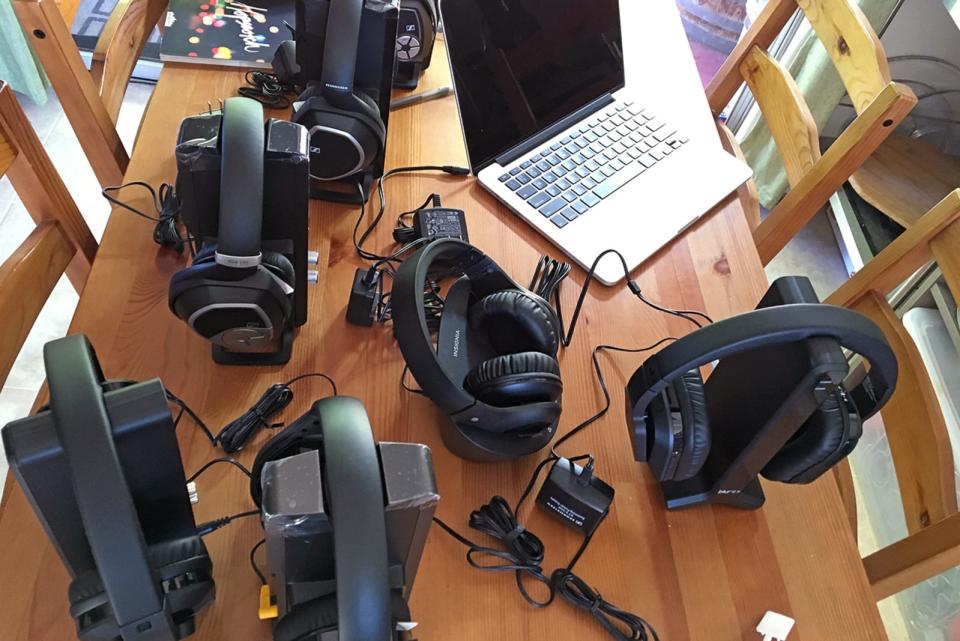
The basic wireless TV headphone system uses RF technology (in varying ranges from 900 MHz to 3.2 GHz) and combines a transmitter, which you plug into your TV or AV receiver, with one or two included pairs of headphones. In recent years, companies have released standalone Bluetooth hubs, which work like the transmitters in the aforementioned systems but will work with any Bluetooth headphones (some systems also include a pair). Bluetooth broadcasts in the frequency range from 2.4 GHz to 2.8 GHz and generally has a more limited range than other RF-based systems, although we don't expect people to wander too far from their TVs when using this type of product.
Based on our previous testing, interviews with experts, and research of other editorial reviews, we focused on the following criteria to evaluate all type of wireless TV headphone systems:
Latency: When watching movies and TV shows with these headphones, we found it very distracting when there was a delay between the image we saw and the sound we heard. This made it harder to enjoy whatever we were watching. As such, if a headphone system created a noticeable gap between video and audio, we were not likely to recommend it.
Sound quality: In our experience, sound quality is not a major distinguishing factor in this category. Most of the headphones sound completely fine, but a few sound very distorted and compressed. None of them sound as good as the wired over-ear headphones that we recommend. That said, we looked for headphones that could clearly render the dialogue, sound effects, and background soundtrack of everything we watched.
Setup: We looked for systems that are relatively easy to add to your existing TV or home theater arrangement, prioritizing those that did not require the purchase of extra cables, power sources, or external batteries. We particularly liked systems that did not require complicated steps to connect their hubs with their headsets.
Comfort level: For the systems that include headphones, we wanted to make sure that they were comfortable enough to wear for at least the length of a movie. We paid particular attention to whether the earcups were padded and if the headband squeezed our head.
Battery life: A functional TV headphone system must have a long enough battery life to at least last through a movie or a few episodes of a TV show. We also paid attention to how the headset is charged, giving special preference to systems that have a charging dock on the hub rather than on a separate piece of equipment.
Once our criteria was in place, we combed through the offerings at Amazon, Best Buy, B&H, and Crutchfield to see what was available. For our latest update, we brought in six new models to test against our previous picks, the Sennheiser RS 165 and Power Acoustik HP-902RFT. Our test included traditional wireless TV headphone systems (like the Noontec Hammo TV and SleepPhones TellyPhones), Bluetooth headphones that are (supposedly) optimized for low latency (like the MEE Audio Matrix Cinema), and Bluetooth hubs (like the MEE Audio Connect Hub, MEE Audio Connect Bluetooth, and the Sennheiser BT T100 Bluetooth Audio Transmitter).

In our last round of testing, Lauren convened a panel to assess the headphones. Using a variety of music, movies, and TV shows with which they were very familiar, Brent, Geoff, and John helped Lauren make her picks. For this update, Daniel tested each of the new models throughout his Brooklyn apartment, focusing more on usability than sound profile, and conferred with Lauren to finalize the picks.
Our pick: Sennheiser RS 165
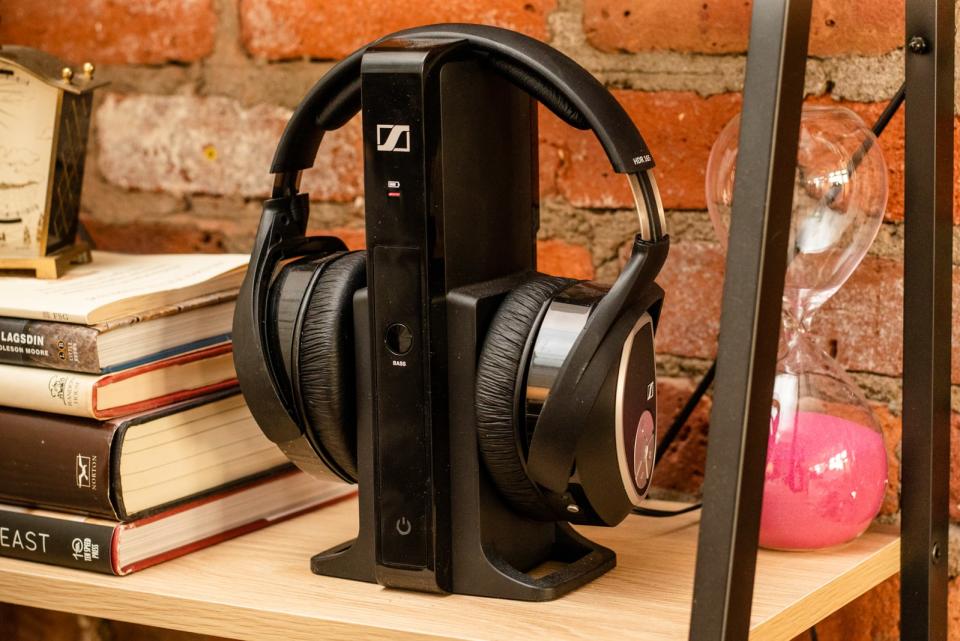
If we needed a pair of wireless TV headphones, the Sennheiser RS 165 headphones are the only ones we would consider buying. These headphones render dialogue, sound effects, and background soundtracks more clearly than any other wireless TV headphone system we tested, with very little noticeable latency. Plus, the headphones are lightweight and comfortable to wear, they're easy to charge, and they're easy to add to most existing TVs or home theater setups. The batteries last long enough to make it through several movies in between charges.
Latency was a huge issue with all of the systems we tested, especially the Bluetooth-based ones. When testing some models, we found it impossible to focus on whatever we were watching, due to the latency between the video and audio. We would see a character move their mouth and then hear what they were saying a few seconds later, as if we were watching a poorly dubbed martial-arts movie. We never noticed this latency while wearing the RS 165 headphones, though, which made it possible to actually enjoy the TV shows we used for this testing.
It also helps that the RS 165 headphones sound pretty good. Dialogue is clear and easy to understand, and you get decent left- and right-channel separation. Our panel noted that the high frequencies seemed a bit boosted, which made small noises (like footsteps on leaves and the crackle of fire) pop a bit more than seemed natural. The panel also agreed that the bass was a bit forward but still generally smooth and defined, as long as you keep the bass-boost feature turned off. They don't sound as good as our favorite wired headphones, but they don't sound distorted or compressed like some TV headphones we've tested.
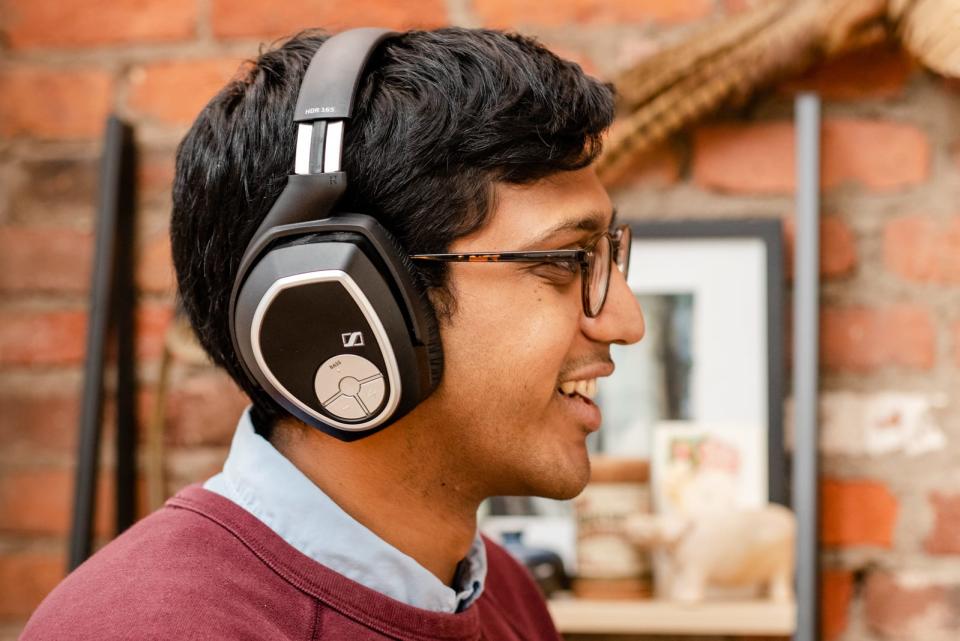
Adding the Sennheiser RS 165 system to an existing TV or home theater setup is relatively easy, depending on the inputs you have available. The package includes the headphones, the transmitter hub with a single 3.5 mm audio input, the power brick (with four adapters for outlets of the US, UK, EU, and AU style ), a 3.5 mm audio cable, and rechargeable batteries for the headphones. If you have a TV with a 3.5 mm audio output, you won't need anything else. But if you have an older TV or are using an AV receiver, you might need an RCA or ¼-inch adapter to make it work.
The RS 165's design is comfortable enough to wear through the length of a movie (and longer). The headphones are lightweight and have an adjustable headband, so they never felt tight on our head. That said, if your head is smaller, you might have trouble getting a great seal because the earcups are a little large (we discuss this problem in the Flaws but not dealbreakers section).
In addition, the RS 165 pair's battery life is plenty long to last through a movie or two. When you're finished watching, the transmitter hub serves as a charging station for the headphones—but you have to make sure you dock them in the cradle properly or they won't charge. The RS 165 system supports the addition of a second pair of headphones, but you'll need to buy those headphones separately. If you want to use more than two pairs of headphones at the same time, check out the Power Acoustik HP-902RFT system, which supports playback through up to four pairs at once.
Flaws but not dealbreakers
We struggled to find a pair of wireless TV headphones that we really loved using. Each one we tested had at least one major issue, and the Sennheiser RS 165 is no exception. As we've mentioned, the headphones sound pretty good, especially when compared with the other TV headphones we tested this round, but not as good as any of our wired headphone picks. If you can just plug a pair of headphones directly into your TV or AV receiver and watch comfortably (the Sony MDR-7506 has a 3-meter-long cord), you'll get a guaranteed better sound experience for less money.
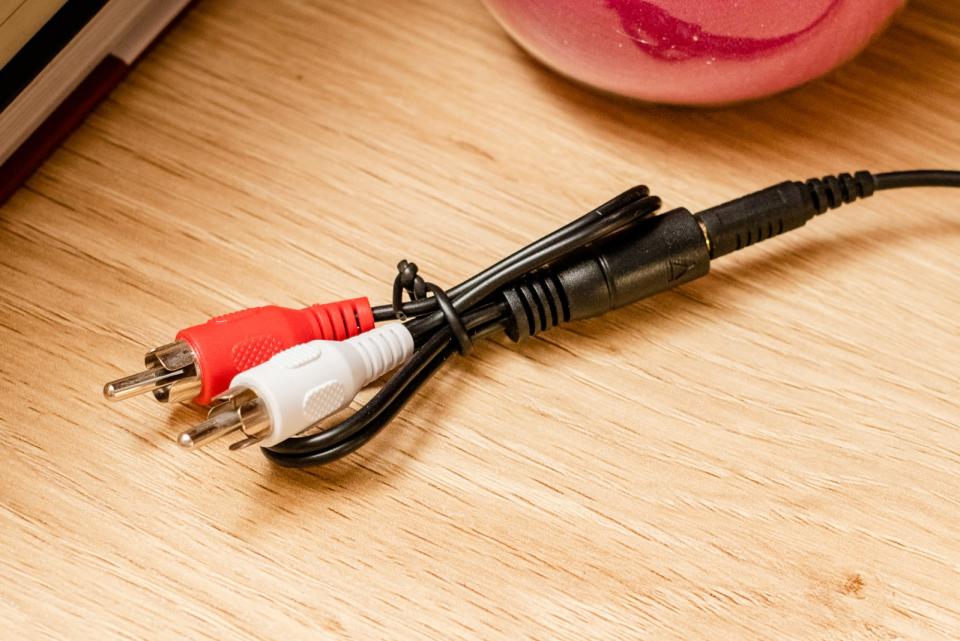
Although the Sennheiser RS 165 system is pretty easy to set up, you might have to purchase some extra cables or adapters to add it to your TV or home theater array. If you want to plug it into the headphone jack of an AV receiver, you might need a ¼-inch adapter. Depending on your TV's output options, you might need an RCA adapter or cable. If you happen to have either of these lying dormant in your junk drawer (as Daniel did), you're all set. But it's really annoying that Sennheiser doesn't include these in the package—although this was a common issue among all of the products we tested.
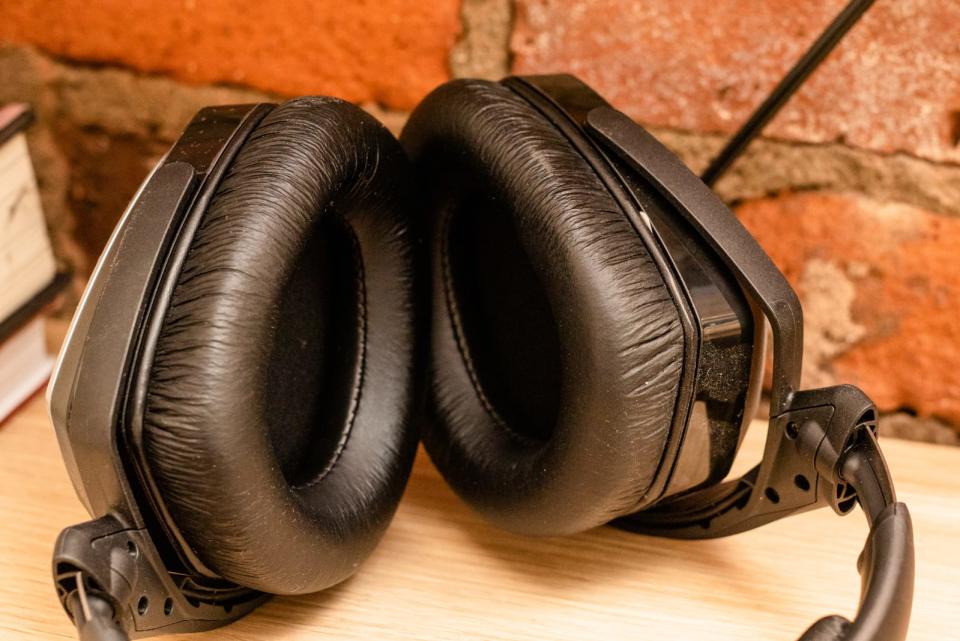
The earcups on the Sennheiser headphones are a little large. This wasn't a big deal for Daniel, who has a relatively large head, but Lauren, who has a smaller head, struggled to get a great seal with them. Since you're likely going to use these in a quiet home environment, we don't think getting a great seal is as important.
Budget pick: Power Acoustik HP-902RFT
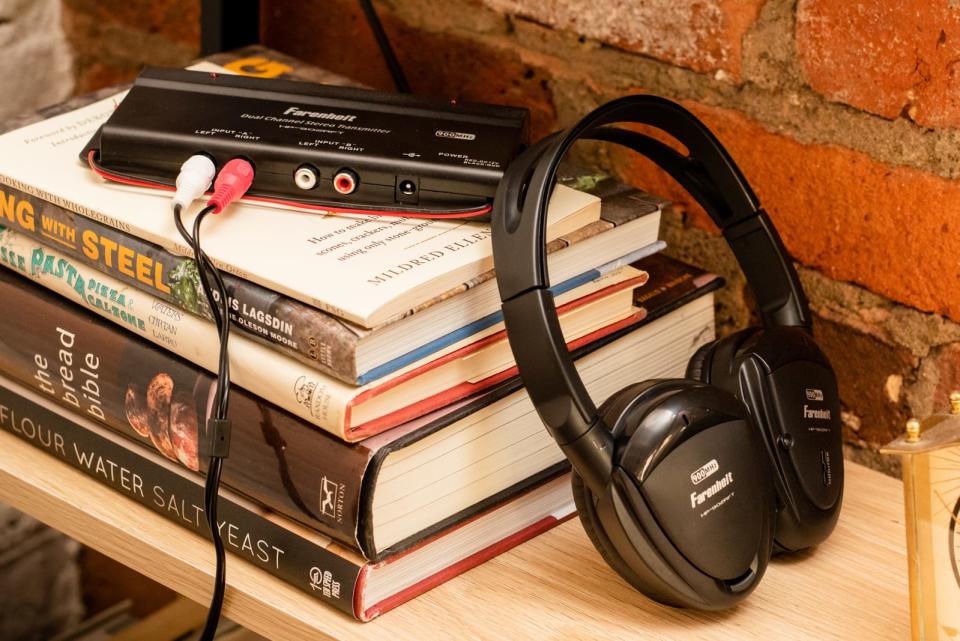
If you don't want to spend more than $100 or you need a system that comes with two (and supports up to four) pairs of headphones, consider the Power Acoustik HP-902RFT. These headphones don't sound as good as the Sennheiser RS 165 pair, the package doesn't include everything you need to get started (like a power supply!), and the transmitter hub is harder to add to your existing TV or home theater setup. But once setup is complete, the system is really easy to use and it renders minimal latency between video and audio.
As Brent put it in an early test panel, these headphones sound a lot better than they have a right to for this price. They sound a little compressed, but the overall balance is relatively even across all frequency ranges. Intense low bass won't drown out everything else happening in a scene, and unlike with some competing models, the consonants on words won't be so intense that they feel like they're piercing your eardrums. Unfortunately, that middle-of-the-road evenness also means that music can sound a little dull and lifeless—nothing really pops. And if you turn the volume way up, you will hear a bit of hiss, especially if you walk a few rooms away from the transmitter. Basically, the HP-902RFT headphones get the job done when you're watching TV or playing a game, but they aren't something you'll sit around and luxuriate in while listening to high-quality recordings. The Sennheiser RS 165 headphones make dialogue a little easier to understand and the score sound a little more exciting, but there is no noticeable difference in latency.
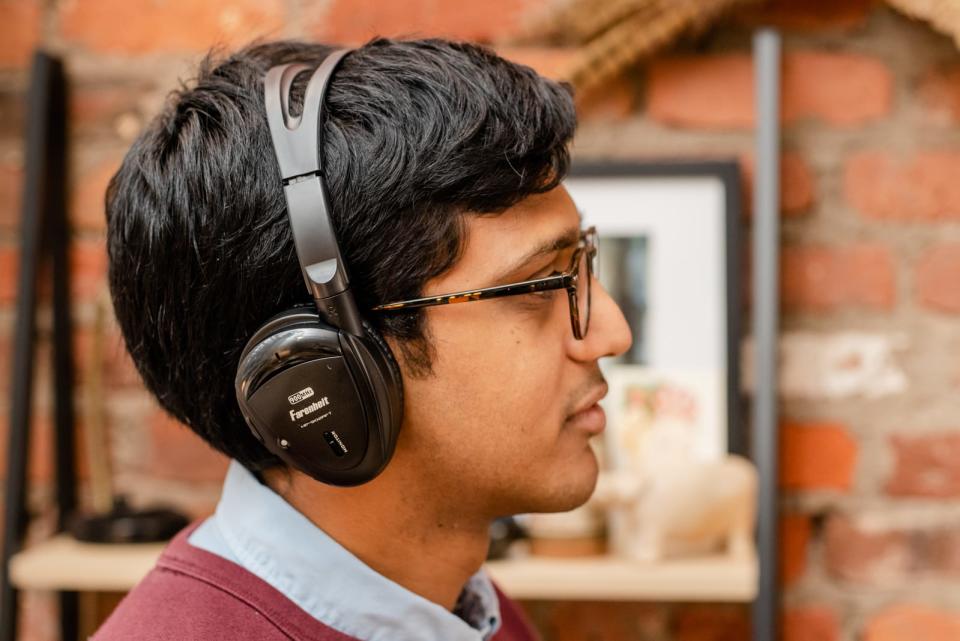
The main issue with the HP-902RFT system is that the package doesn't include anything beyond the transmitter, the headphones, and their cases, so you'll need to buy a power supply, some AAA batteries, and potentially RCA cables. Although the lack of a built-in rechargeable battery means you don't have to worry about improperly seating the headphones on a cradle and finding them uncharged when you want to use them (a likely problem with a few of the other models we tested), it also means you'll need to keep disposable batteries on hand or invest in a rechargeable set of AAAs. And if you use the headphones a lot, purchasing batteries frequently could get annoying and costly.
The HP-902RFT system is really easy to use. The headphones have a volume wheel, a mute button that allows you to hear what's going on around you, and a switch that allows you to toggle between the two channels broadcast by the transmitter (via separate pairs of RCA inputs). That can come in handy if, say, you want to watch a movie while your kid plays Minecraft.
The headphones feel plasticky and a little cheap, but they're comfortable enough to wear through the entirety of a movie. And their earcups are large enough to accommodate most ears but not so large that they won't fit on smaller heads.
How to connect the transmitter to your TV
You can connect TVs to your audio gear in many different ways, depending on brand, model, year of manufacture, and so forth. So, before you buy a pair of wireless TV headphones, you should look at the side or back of your TV. What kinds of audio ports does it have? Look for a label that says "Out" or "Output."
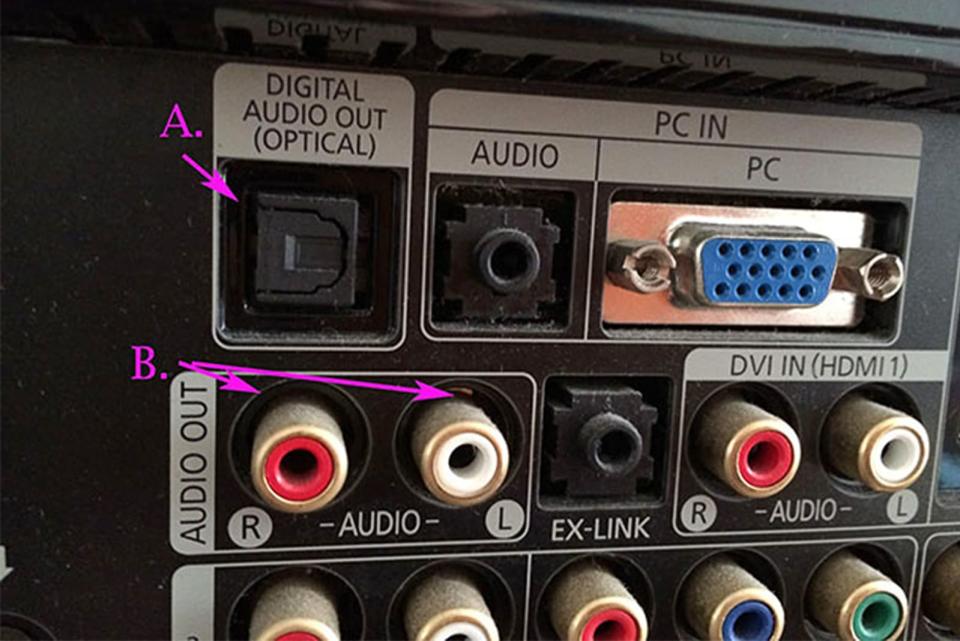
Does it look like A in the pictures above? That's an optical digital output. If the wireless TV headphones you're interested in don't have an optical input (our picks don't), you'll need to get a digital-to-analog converter such as this one, which will work with either of our picks and typically costs less than $30. If you are using the Power Acoustik HP-902RFT, you'll need a male-to-male RCA cable, too.
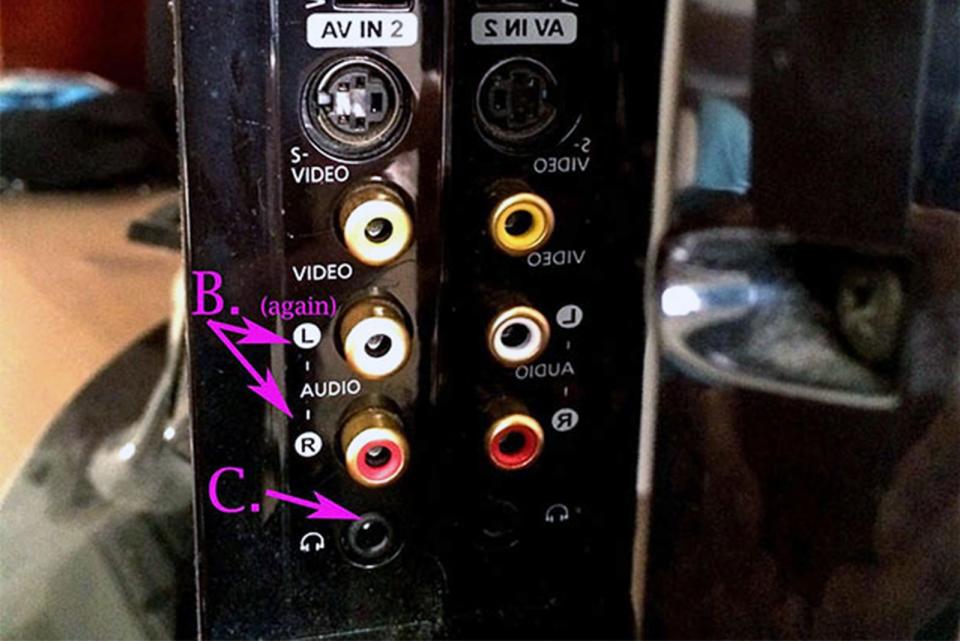
If you have a TV with Dolby surround output and you still want to use the optical out, you'll have to do one of two things. Either you'll need to go into your TV's settings and turn off Dolby Digital, using PCM encoding instead (this action will let you use the less expensive D/A converter mentioned above), or you can leave Dolby Digital on and buy this D/A converter and this optical cable, as well as this adapter for the HP-902RFT. If you're using the Sennheiser RS 165, get this adapter instead.
If your TV's audio output looks like B in the pictures above you'll need an adapter that goes from RCA to ⅛ inch to connect to the Sennheiser RS 165 transmitter, or you'll need this cable for the Power Acoustik model.
Does the output look like C in the pictures above? For the Sennheiser RS 165—congratulations!—you don't need anything at all to convert. It's already a ⅛-inch jack and the cable is included—just plug and play. You'll need this RCA–to–⅛-inch cable for the Power Acoustik model.
Bluetooth hubs: A great idea that's not ready for prime time
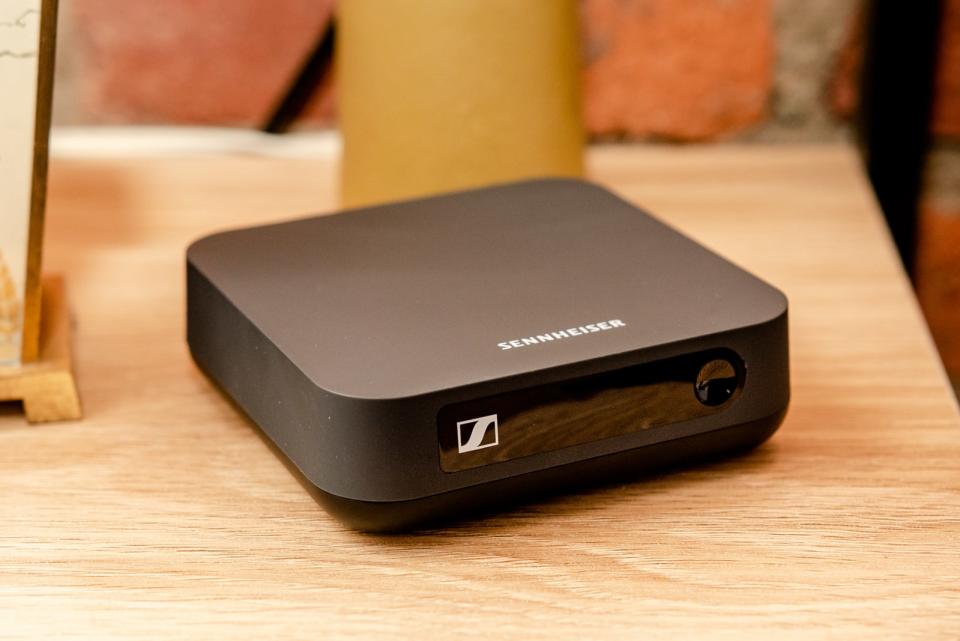
We really like the idea of the Bluetooth hub that lets you use your own Bluetooth headphones as wireless TV headphones. Pretty much all of our wireless headphone picks will sound better than any of the headphones we tested for this guide, and you can use them for all of your other listening needs. Unfortunately, as we discussed above, Bluetooth leads to a lot of latency between what you see on the screen and hear in your headphones. With every Bluetooth hub we tried, this effect was obvious—and frustrating enough to noticeably worsen our watching experience.
The competition
We tested several new wireless TV headphones against our top picks at the end of 2018, including:
MEE Audio Connect Hub: This hub didn't make any of the Bluetooth headphones we connected to it sound any worse, and we appreciated how easy it was to add to an existing TV setup. Unfortunately, as with all the Bluetooth hubs we tested, the hub rendered far too much latency between the image and audio.
MEE Audio Connect Bluetooth: This hub rendered too much latency between the video and audio, even when we used the included headphones. The headphones also sounded compressed and washed out across all frequencies.
MEE Audio Matrix Cinema: We tested these Bluetooth headphones as a solution that didn't require a hub. If you watch movies or TV shows only on something with Bluetooth capabilities, you wouldn't need something as complicated as our picks. These headphones had lower latency than other Bluetooth headphones we've used, but it was still enough to bother us while watching a movie. Plus, these headphones sounded worse than many other Bluetooth headphones we've tested in this price range—particularly in the low end. If you just want Bluetooth headphones, you'd be better off with one of our wireless headphone picks.
Noontec Hammo TV: We appreciated that this set of TV headphones came with everything that you'd actually need to use them, including charging and input cables. However, these headphones had much more noticeable latency than the Sennheiser RS 165 pair. They are also less comfortable to wear and had a slightly distorted sound profile.
Sennheiser BT T100 Audio Transmitter: This Bluetooth hub supports the AptX codec, which means that if you have the right headphones the hub should render less latency for whatever you're watching. Unfortunately, even when we connected the V-Moda Crossfade 2 Wireless headphones (which support the same codec), we still noticed a lot of latency between the video and audio.
TellyPhones by SleepPhones: This hub system includes a Bluetooth headphone built into a soft headband. That headphone is definitely comfortable enough to sleep in, but unfortunately it struggles to render low and high frequencies, making anything you listen to sound a little compressed. Additionally, regardless of whether you connect the included headphones or other low-latency Bluetooth headphones, the TellyPhones hub renders very noticeable latency. If you just want a pair of Bluetooth headphones you can sleep in, the separately sold SleepPhones might be a good solution. But we don't think the entire system works well enough to recommend it.
We tested many other wireless TV headphone systems in previous years. Here are some of the ones that are still available:
Sennheiser RS 120: Moderately priced (less than $80 at the time of this writing), the RS 120 set has a nifty charging cradle in its transmitter base, but unfortunately we just didn't love these headphones. One panelist pointed out how quickly they ended up with hiss (you have to tune them in on the side of the headphones, which you can easily bump), another disliked the build quality, and a third found them uncomfortable to wear for long. All of us commented on the sizzling high end of the frequency; every snare hit had a "tss tss" piercing aspect that was unpleasant. Overall, if you want to save money, get the Power Acoustik HP-902RFT instead.
Sennheiser RS 160: This model was a previous top pick, but alas, it has been discontinued. You can still find it here and there, however. If you see it, you should snap it up because for everyone on our panel it was the best-sounding model, hands down, even compared with the RS 165. All of us also found this pair to be very comfortable despite our various head shapes. The headphones are light, the earpads are sturdy yet have a nice squish to them, and nothing pinched or chafed. We could easily watch a movie with no complaints. We wish this model was still being made.
Sennheiser RS 175: The RS 175 pair ended up being a huge flop with our test panel. Brent summed it up: "These are a mess." The RS 175 has a bass-boost option; in our tests, with the bass boost turned off, the overall sound was thin and edgy, lifeless. Piano sounded like a bad digital-keyboard representation of a piano sound. The low end was somewhat pitchless, so hip-hop and intense orchestral soundtracks (like that of The Lord of the Rings) seemed to lose their oomph. Geoff also remarked that the highs had a sizzly quality when the volume was turned up.
Sennheiser RS 185: The RS 185 model has an open-back design, which can be a good thing or a bad thing depending on how you want to use your wireless TV headphones. If you're shopping for a pair of wireless headphones to watch TV next to a sleeping partner, the RS 185 pair isn't for you. If you're still interested, the RS 185 set has the most spacious sound of all of the wireless TV headphones that Sennheiser currently makes. It also produces the most balanced sound, from bass to mids to the lower treble. And yet, the sound quality isn't a vast enough improvement over that of the RS 165 to justify the large increase in price.
Sennheiser RS 195: Created in conjunction with the Fraunhofer Institute for Digital Media Technology, the RS 195 pair is designed for people with slight hearing disabilities. Because this model has so many options and settings, we were hoping that it might hit the sweet spot as something that a person with hearing loss and a family member with typical hearing abilities could share. Unfortunately, our able-hearing panelists were exceptionally unhappy with the sound. We realize that we're not who the RS 195 was designed for, though, so it would be unfair for us to criticize without taking that into account. We'll just say that it is entirely possible that someone with a particular kind of moderate hearing loss might find the RS 195 sound profile helpful, and leave it at that.
This guide may have been updated by Wirecutter. To see the current recommendation, please go here.
When readers choose to buy Wirecutter's independently chosen editorial picks, Wirecutter and Engadget may earn affiliate commissions.
